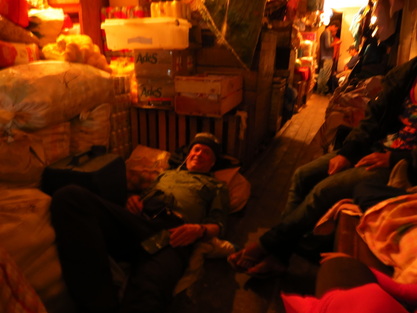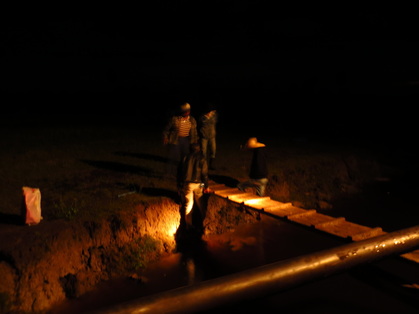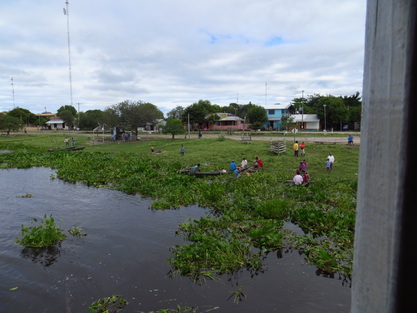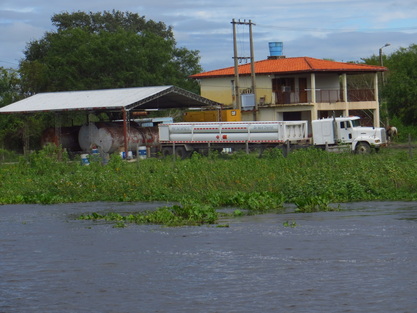14-16/5/ 2014
Vallemi to Bahia Negra on the Aquidaban
600km upriver.
The Aquidaban was late arriving in Vallemi, so the morning saw me visit the historical cemetery, buy a new phone charger and use the wifi at the local waterfront gas station.
The weather was still overcast, but warm.
While waiting, another boat was in port unloading, low and behold, it was the boys aboard the Osmar, I hurried down to say gidday, it was great to see them. They unsuccessfully tried to get me into the hold to help unload.
From here, they were going up river to get Calviva from the factories that produced it just out of town.
Soon my home for the next few days sidled alongside the Osmar and secured lines. It was 1500 hrs.
I grabbed my gear and went onboard to look at things.
It did not take long to realise that life onboard the Osmar was Like a cruise ship compared to what I had observed on the Aquidaban.
Firstly, it was unbelievably crowded. It reminded me of what shipping must have been like in the early days. The slave transportation in particular.
The fore deck was covered in every imaginable cargo, most gaps were occupied by passengers, getting setup for the night ahead.
Space was at a premium.
Many men were smoking, drinking beer or tereré.
The two gangways that led to the aft end of the vessel were about a metre wide and were occupied by the floating market, here 4 women, port and starboard were selling fruit, veges and every other staple needed for ones existence.
They also sold clothing, shoes, blankets, batteries, pots and pans to name a few items.
At least I was going to have access to fresh fruit the whole way. Things could have been a lot worse.
To the stern on same level were the toilets, all waste, hit the river just below the surface.
It was later discovered, the experience was not so bad if a smoker had just used the loo. The expelled smoke was way better than the other odours from within.
They were clean as could be for their locality but with constant use there was an awful lingering about the air around and within them.
Upstairs was the galley and cafe, here you could buy good meals, beer and get a thermo of hot water for mate.
Hammocks were strung up everywhere.
Up here were the private cabins, tiny they were with four bunks in each.
The floor up here was tin plate, probably to keep things dry, below.
The wheelhouse had a commanding view of the foredeck on the all timber vessel built 50 years ago.
The engine was a Scania 6 cylinder, 320 hp, it was housed beneath the staircase leading to the galley. The engineer was never far away.
It ran incredibly smoothly, the nice thing about it all was that on the fore deck it was like being on a yacht, there was no hint that an engine was propelling us.
Cargo was still being loaded and unloaded by hand.
Just upstream were basic factories with plumes of white smoke arising this was where they cooked the limestone to make quicklime.
Come 2030 we had all secured sleeping spots on the foredeck, it was a clear mild evening.
Mine was slightly interfering with another man’s spot, he was not too impressed. My apologies were given, and my legs retracted into the fetal position.
First stop of many was at Puerto Esperanza, a Chamacoco indigenous community, here people were greeting us, half the town was on the shore. People departed and others took their place. All the while goods were being unloaded.
This service is all that supplies these communities on the upper Paraguay. The roads are closed most of the year.
Every port sees heaps of people come onboard to buy things from the markets. Mums are buying toys for the kids, men are buying beer in cans and teenagers are buying fashion items.
The guys handling the freight are well built and strong, at one time one of them was single handled carrying the rear end of a new boat trailer as it came aboard, all this up a springy gang plank, I might add.
At the smaller indigenous communities, the skipper just ran her aground in the grasses.
The river is well up on normal levels at the moment.
We pulled in at these places all night, sleep, if you could call it that was very patchy. Each port required us to be there for up to an hour and a half.
By 0300, sleep was needed in a big way, I found a spot on some sacks of Galletas, small dried bread balls, this was great, the cold air of the morning had set in .I climbed into my sleeping bag and made the most of the precious little space afforded to me.
This experience had not been endured before. During the middle of the night there was an altercation on the fore deck with the guy who I had encroached on earlier, the skipper had the foredeck light trained on those involved.
Most people are speaking in Guarainí, so I could only guess what they were on about, it resolved peacefully.
In the morning, I headed up to the galley with my mate, and got hot water and had some pasta and beef for breakfast.
Many men were enjoying the local canned beer Ouro Fino for their breakfast.
Next stop was Puerto Guaraní.
Stopping at Porto Olimpo, life aboard changed dramatically, as lots of people disembarked, it is a large town. Space was now more available.
Up until , there was always someone within a metre of me.
The foredeck was now a place where a walk could be enjoyed. Fireworks were let off in most ports to herald our arrival.
I was the only foreigner onboard. I was so thankful I knew enough Spanish to have a basic chat with people. Without this, being on your own, it literally would have been two and a half days without talking.
People from all walks of life were onboard. Many were obviously poor, intermingled teachers, estancia workers, government people and people visiting friends and family.
One guy was up here to buy bull calves and spend a week, walking them from Bahia Negra to Porto Olimpo to be fattened on his property. This takes 1 year, he told me.
The land on each side of the river is dominated by the Wax Palm (Carperinicia alba) or as it is known in Guaraní, the Karanday Palma dominated the landscape, Water Hyacinth lined both shores and dense scrub covered the lower levels with tall grasses in the more elevated areas.
Brazil now is on the eastern shore. Some larger communities were passed.
Two large paddle steamer type craft were seen. These accomadate tourists to go fishing for the many sport fish up here.
Most tourists hiring them are Brasileros.
The Aquidaban
Shades of grey many green one brown
Slithers darker give the sky a character
Becoming more settled
As the karanday palms pierce from below
The palms serrated green balls
Above the Chaco
Brazil to starboard Paraguay port
Palms reaching the shore in Brazil
Shrubs impenetrable in Paraguay
Palms always in the background
Camelote a low tier at the waters edge
Restricting acess to the land
Green islands always drifting by
Many their age revealed in the leaf
The Aquidaban plies her way
Up this watery road
Against the flow
The camelote has nowhere to go
In the galley facing aft
Onions capsicums potatoes with beef
Prepared all morning and mandioca
Water always flowing from the sink tap
The engine below sees to that
A gentle wake
Always angles to the shore
Its last energy
Spread among the camalote
Waiting at the waters edge
Protecting the land behind
Morning in the galley
Grey skies now patchy blue
The night not a star
Clouds and gentle rain
Distant forks at times paved our way the night before
All enjoying tortillas from the cocinero
The palms still fill the open window frames
The river the only passage
Dragonflies
Their wings in the sunlight
Oh how Paraguayos
Enjoy an early morning beer
Such is life here
On the river Paraguay
Tranquilo is its toll
Conversation Guaraní a little Español.
Another local told me here is a micro climate here on the river. An area 40 km either side receives more rain than the land outside this zone.
This is understandable, this river is absolutely huge.
During the day, time was spent, eating fruit, sleeping,chatting, thinking and studying Spanish.
A lot of mate was also consumed. The second night was spent huddled up amongst goods in one of the markets, it was actually quite comfortable.
Much fruit was eaten, an apple was costing 50c.
The cocinero onboard showed me a video on his phone of a Jaquar taking a Jacaré on a sand bank in the river and drowning it.
Pumas and Jaguars are common up here. Piranhas are also present in the waters up here.
During the passage, many people were seen throwing beer cans and every other piece of rubbish into the river. The stall ladies were shameless in their tossing of debris into the waters.
Signs were displayed, one anyway! discouraging this behaviour.
Interestingly here in Paraguay Guaraní is spoken by almost everyone, and is used in communicating whilst at home.
Even the most uneducated are bilingual and many can also speak Portuguese.
It makes me feel so inadequate.
Such is life in the Pacific Ocean in NZ and Australia away from close neighbours.
We finally got into Bahia Negra at 1530.
A few facts:
Bahia Negra is the most north eastern population in Paraguay with 1000 people.
Bolivia is 14km to the north, there is limited employment, that of only cattle ranching and fishing. The Ishir are the local indigenous people. The Aquidaban is the only transport in the wet season.
It had been a journey of endurance in many ways, but above all such a special insight into life here in Alto Paraguay.
The woman onboard with their markets more or less live on the boat. They slept on the side benches at their market.
They showered in the loos which had river water piped from the engine.
My arrival in Bahia Negra saw me none the worse for wear, just even more appreciative of things previously taken for granted.
Vallemi to Bahia Negra on the Aquidaban
600km upriver.
The Aquidaban was late arriving in Vallemi, so the morning saw me visit the historical cemetery, buy a new phone charger and use the wifi at the local waterfront gas station.
The weather was still overcast, but warm.
While waiting, another boat was in port unloading, low and behold, it was the boys aboard the Osmar, I hurried down to say gidday, it was great to see them. They unsuccessfully tried to get me into the hold to help unload.
From here, they were going up river to get Calviva from the factories that produced it just out of town.
Soon my home for the next few days sidled alongside the Osmar and secured lines. It was 1500 hrs.
I grabbed my gear and went onboard to look at things.
It did not take long to realise that life onboard the Osmar was Like a cruise ship compared to what I had observed on the Aquidaban.
Firstly, it was unbelievably crowded. It reminded me of what shipping must have been like in the early days. The slave transportation in particular.
The fore deck was covered in every imaginable cargo, most gaps were occupied by passengers, getting setup for the night ahead.
Space was at a premium.
Many men were smoking, drinking beer or tereré.
The two gangways that led to the aft end of the vessel were about a metre wide and were occupied by the floating market, here 4 women, port and starboard were selling fruit, veges and every other staple needed for ones existence.
They also sold clothing, shoes, blankets, batteries, pots and pans to name a few items.
At least I was going to have access to fresh fruit the whole way. Things could have been a lot worse.
To the stern on same level were the toilets, all waste, hit the river just below the surface.
It was later discovered, the experience was not so bad if a smoker had just used the loo. The expelled smoke was way better than the other odours from within.
They were clean as could be for their locality but with constant use there was an awful lingering about the air around and within them.
Upstairs was the galley and cafe, here you could buy good meals, beer and get a thermo of hot water for mate.
Hammocks were strung up everywhere.
Up here were the private cabins, tiny they were with four bunks in each.
The floor up here was tin plate, probably to keep things dry, below.
The wheelhouse had a commanding view of the foredeck on the all timber vessel built 50 years ago.
The engine was a Scania 6 cylinder, 320 hp, it was housed beneath the staircase leading to the galley. The engineer was never far away.
It ran incredibly smoothly, the nice thing about it all was that on the fore deck it was like being on a yacht, there was no hint that an engine was propelling us.
Cargo was still being loaded and unloaded by hand.
Just upstream were basic factories with plumes of white smoke arising this was where they cooked the limestone to make quicklime.
Come 2030 we had all secured sleeping spots on the foredeck, it was a clear mild evening.
Mine was slightly interfering with another man’s spot, he was not too impressed. My apologies were given, and my legs retracted into the fetal position.
First stop of many was at Puerto Esperanza, a Chamacoco indigenous community, here people were greeting us, half the town was on the shore. People departed and others took their place. All the while goods were being unloaded.
This service is all that supplies these communities on the upper Paraguay. The roads are closed most of the year.
Every port sees heaps of people come onboard to buy things from the markets. Mums are buying toys for the kids, men are buying beer in cans and teenagers are buying fashion items.
The guys handling the freight are well built and strong, at one time one of them was single handled carrying the rear end of a new boat trailer as it came aboard, all this up a springy gang plank, I might add.
At the smaller indigenous communities, the skipper just ran her aground in the grasses.
The river is well up on normal levels at the moment.
We pulled in at these places all night, sleep, if you could call it that was very patchy. Each port required us to be there for up to an hour and a half.
By 0300, sleep was needed in a big way, I found a spot on some sacks of Galletas, small dried bread balls, this was great, the cold air of the morning had set in .I climbed into my sleeping bag and made the most of the precious little space afforded to me.
This experience had not been endured before. During the middle of the night there was an altercation on the fore deck with the guy who I had encroached on earlier, the skipper had the foredeck light trained on those involved.
Most people are speaking in Guarainí, so I could only guess what they were on about, it resolved peacefully.
In the morning, I headed up to the galley with my mate, and got hot water and had some pasta and beef for breakfast.
Many men were enjoying the local canned beer Ouro Fino for their breakfast.
Next stop was Puerto Guaraní.
Stopping at Porto Olimpo, life aboard changed dramatically, as lots of people disembarked, it is a large town. Space was now more available.
Up until , there was always someone within a metre of me.
The foredeck was now a place where a walk could be enjoyed. Fireworks were let off in most ports to herald our arrival.
I was the only foreigner onboard. I was so thankful I knew enough Spanish to have a basic chat with people. Without this, being on your own, it literally would have been two and a half days without talking.
People from all walks of life were onboard. Many were obviously poor, intermingled teachers, estancia workers, government people and people visiting friends and family.
One guy was up here to buy bull calves and spend a week, walking them from Bahia Negra to Porto Olimpo to be fattened on his property. This takes 1 year, he told me.
The land on each side of the river is dominated by the Wax Palm (Carperinicia alba) or as it is known in Guaraní, the Karanday Palma dominated the landscape, Water Hyacinth lined both shores and dense scrub covered the lower levels with tall grasses in the more elevated areas.
Brazil now is on the eastern shore. Some larger communities were passed.
Two large paddle steamer type craft were seen. These accomadate tourists to go fishing for the many sport fish up here.
Most tourists hiring them are Brasileros.
The Aquidaban
Shades of grey many green one brown
Slithers darker give the sky a character
Becoming more settled
As the karanday palms pierce from below
The palms serrated green balls
Above the Chaco
Brazil to starboard Paraguay port
Palms reaching the shore in Brazil
Shrubs impenetrable in Paraguay
Palms always in the background
Camelote a low tier at the waters edge
Restricting acess to the land
Green islands always drifting by
Many their age revealed in the leaf
The Aquidaban plies her way
Up this watery road
Against the flow
The camelote has nowhere to go
In the galley facing aft
Onions capsicums potatoes with beef
Prepared all morning and mandioca
Water always flowing from the sink tap
The engine below sees to that
A gentle wake
Always angles to the shore
Its last energy
Spread among the camalote
Waiting at the waters edge
Protecting the land behind
Morning in the galley
Grey skies now patchy blue
The night not a star
Clouds and gentle rain
Distant forks at times paved our way the night before
All enjoying tortillas from the cocinero
The palms still fill the open window frames
The river the only passage
Dragonflies
Their wings in the sunlight
Oh how Paraguayos
Enjoy an early morning beer
Such is life here
On the river Paraguay
Tranquilo is its toll
Conversation Guaraní a little Español.
Another local told me here is a micro climate here on the river. An area 40 km either side receives more rain than the land outside this zone.
This is understandable, this river is absolutely huge.
During the day, time was spent, eating fruit, sleeping,chatting, thinking and studying Spanish.
A lot of mate was also consumed. The second night was spent huddled up amongst goods in one of the markets, it was actually quite comfortable.
Much fruit was eaten, an apple was costing 50c.
The cocinero onboard showed me a video on his phone of a Jaquar taking a Jacaré on a sand bank in the river and drowning it.
Pumas and Jaguars are common up here. Piranhas are also present in the waters up here.
During the passage, many people were seen throwing beer cans and every other piece of rubbish into the river. The stall ladies were shameless in their tossing of debris into the waters.
Signs were displayed, one anyway! discouraging this behaviour.
Interestingly here in Paraguay Guaraní is spoken by almost everyone, and is used in communicating whilst at home.
Even the most uneducated are bilingual and many can also speak Portuguese.
It makes me feel so inadequate.
Such is life in the Pacific Ocean in NZ and Australia away from close neighbours.
We finally got into Bahia Negra at 1530.
A few facts:
Bahia Negra is the most north eastern population in Paraguay with 1000 people.
Bolivia is 14km to the north, there is limited employment, that of only cattle ranching and fishing. The Ishir are the local indigenous people. The Aquidaban is the only transport in the wet season.
It had been a journey of endurance in many ways, but above all such a special insight into life here in Alto Paraguay.
The woman onboard with their markets more or less live on the boat. They slept on the side benches at their market.
They showered in the loos which had river water piped from the engine.
My arrival in Bahia Negra saw me none the worse for wear, just even more appreciative of things previously taken for granted.
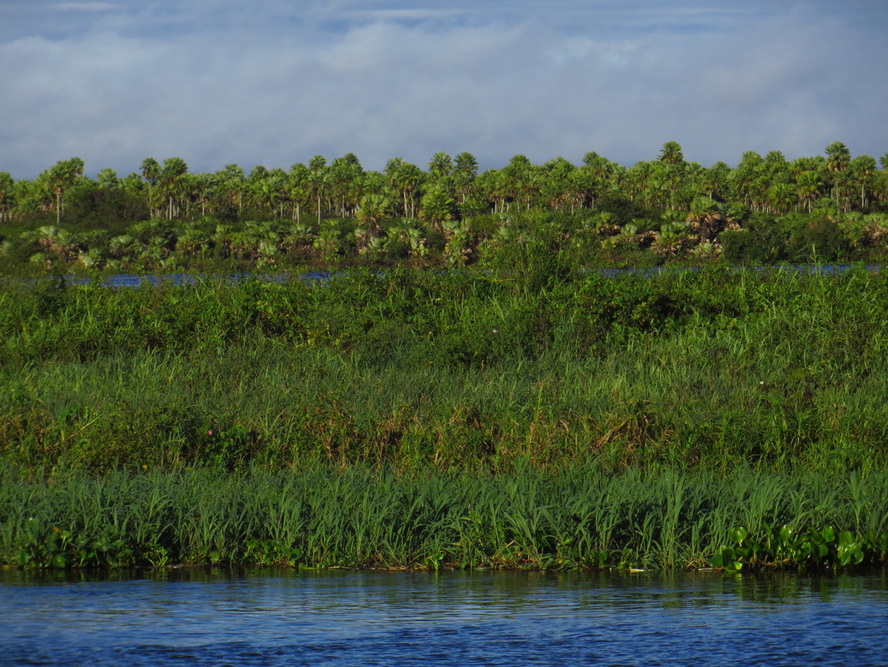 Typical shore side vegetation
Typical shore side vegetation
